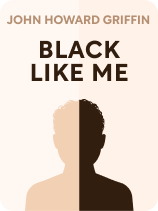

This article is an excerpt from the Shortform book guide to "Black Like Me" by John Howard Griffin. Shortform has the world's best summaries and analyses of books you should be reading.
Like this article? Sign up for a free trial here.
Looking for a book review of Black Like Me? What criticism or praise did John Howard Griffin’s book receive?
John Howard Griffin wrote Black Like Me after conducting a social experiment in the segregated Southern U.S. Since its publication, book reviews of Black Like Me have both praised and criticized Griffin for his work and the methods he used.
Read on for a book review of Black Like Me, based on an analysis of its critical reception.
Black Like Me Review
In 1959, white journalist John Howard Griffin darkened his skin to appear like a Black man, then traveled for six weeks throughout the segregated Southern U.S. Griffin predicted that he’d experience racial discrimination, and he hoped this outcome would convince white Americans that the U.S. was not the racism-free country they thought it was. In Black Like Me, Griffin’s account of his journey, he argues that his hypothesis was correct: Black Southerners faced brutal racism. In this article, we’ll present a book review of Black Like Me, based on the critical reception of Griffin’s book and the methods he used to carry out his experiment.
Since its publication, Black Like Me has been popular—and controversial. The book became a worldwide hit, and it was eventually adapted into a movie. Several prominent, Black-led organizations, such as the National Council of Negro Women, praised Griffin for his work. However, Griffin’s writing also drew intense criticism, particularly from white supremacist groups such as the Ku Klux Klan. After receiving multiple death threats from these groups, Griffin and his family relocated to Mexico. Eventually, Griffin returned to the U.S., where he became involved in the Civil Rights Movement and continued to write about racial equality.
Critical Reception of Black Like Me and Similar Experiments
To begin the book review of Black Like Me, we’ll look at how Griffin’s book was critically recieved at the time of publication in addition to similar books of the time. Griffin wasn’t the first white journalist to embark on an experiment like this—nor was he the last. In 1948, journalist Ray Sprigle darkened his skin to appear Black and spent a month traveling through the Deep South. He later published his account of this experiment in his book, In the Land of Jim Crow. In 1968, journalist Grace Halsell darkened her skin to appear Black, lived in Harlem and Mississippi, and published her experiences in her book, Soul Sister. Sprigle, Griffin, and Halsell shared the same motives for their experiments: to experience what it was like to be Black and use their insights to convince readers that racism was real and pervasive.
Many have praised these three journalists for shining the spotlight on the brutality of racism. Among those who praise them, some clarify that these journalists’ works are educational for white readers—but may be less educational for non-white readers (who already know racism well). For instance, in a book review of Black Like Me, civil rights organizer Kwame Ture said that Black Like Me “is an excellent book—for whites.”
Others have critiqued these three journalists’ experiments for failing to accomplish their goals of honestly portraying racism and convincing readers to care about it. English professor Alisha Gaines, author of Black for a Day (a book about white people passing as Black), argues that these journalists’ books paint an incomplete picture of Blackness. For example, Sprigle only wrote about Black misery, not the full range of experiences that characterized Black life.
Furthermore, Gaines contends that these journalists’ books failed to inspire notable movements of anti-racist solidarity. Experiments like theirs convey the message that white people can reduce racism by empathizing with Black people. But empathy is only useful if it inspires white people to take meaningful antiracist action—and there’s no evidence that these books did so.
Griffin’s Justification for His Methods
Griffin insists that his experimental method of disguising himself as Black was the only way he’d be able to investigate his questions about racism because Black people typically didn’t reveal their experiences of racism to white people. Griffin names two reasons why.
First, he claims that there was little communication between Black and white Southerners. (Shortform note: Griffin doesn’t state why this communication was limited, but we can infer that this lack of communication was largely due to the South’s Jim Crow laws, which created social segregation. We’ll explore these laws in a later section).
Second, Griffin argues that Black people feared that if they were honest about racism, white people wouldn’t believe them—or worse, white people would retaliate. (Shortform note: Griffin doesn’t specify how white people retaliated. Historical records reveal that when Black people resisted racial injustice in the 1950s, white police officers and community members often responded with riots, assaults, and bombings.)
Based on these two reasons, Griffin contends that passing as a Black man would provide him with an insider view of racism that he wasn’t privy to as a white man. He predicted that Southerners would read him as Black, and as a result, Black people would confide in him and white people would mistreat him. This experience would shed light on the degree to which Black Southerners experienced racism.
How Necessary Were Griffin’s Methods?
Griffin claims that disguising himself as a Black man was the only way he could have accomplished his goals of gaining an insider view of racism and proving to white Americans that racism existed. While some book reviews agree that methods he used to write Black Like Me were necessary to accomplish these goals, others claim that there were better ways he could have achieved them.
Perspective 1: Griffin’s methods supported his goals. Some book reviews argue that Griffin’s whiteness made his messages in Black Like Me about racism more palatable for white readers. In the 1950s, white people tended to disregard Black people’s claims about racism and were more likely to believe a fellow white person’s ideas. Griffin’s white perspective both drew white readers and verified Black people’s claims, lending them credibility in the eyes of white readers.
Perspective 2: There were better ways Griffin could have accomplished his goals. Some book review critics of Black Like Me argue that Griffin should have used his privilege as a white journalist in a better way: by publicizing existing insider views of Blackness. They claim that he should have elevated Black people’s authentic voices instead of trying to speak for Black people by pretending to be one of them. Speaking for Black people risked misrepresenting their experiences and eclipsing their existing accounts.
How might Griffin have elevated Black people’s authentic voices? First, he could have promoted books by Black authors. In the 1950s, there were myriad books by Black authors that provided an authentic, insider view of U.S. racism, such as James Baldwin’s essay collection, Notes of a Native Son.
Second, Griffin could have published news about racism. For instance, he could have followed the example of Anne Braden, a white Southern journalist. As Catherine Fosl explains in her biography of Braden, Subversive Southerner, Braden mobilized white support for antiracist efforts. Starting in 1957, she edited Southern Patriot, a publication that educated readers about racial justice efforts and persuaded white Southerners to oppose segregation.

———End of Preview———
Like what you just read? Read the rest of the world's best book summary and analysis of John Howard Griffin's "Black Like Me" at Shortform.
Here's what you'll find in our full Black Like Me summary:
- The 1959 story of a white man who spent six weeks living as a Black man
- The brutal racism Black southerners faced in the mid-1900s
- Griffin’s insights about hope for racial progress in the South






